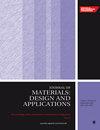Interfacial microstructure and mechanical properties in diffusion bonded Inconel 718 to austenitic stainless-steel joints
IF 2.2
4区 材料科学
Q3 MATERIALS SCIENCE, MULTIDISCIPLINARY
Proceedings of the Institution of Mechanical Engineers, Part L: Journal of Materials: Design and Applications
Pub Date : 2024-08-02
DOI:10.1177/14644207241269012
引用次数: 0
Abstract
Diffusion bonding (DB) of Inconel (IN718) with Austenitic Stainless Steel (SS-304L) was conducted by varying the bonding temperatures and times at 5 MPa of pressure under vacuum. The optimized joint interface was evaluated for its mechanical, nanomechanical, microstructural, and compositional analyses using shear and Vickers hardness tests, optical and scanning electron microscopy (OM & SEM) equipped with energy dispersive spectroscopy (EDS), X-ray diffraction (XRD) and nanoindentation. The results showed that the optimized bonding parameters for achieving a stable joint interface were 950 °C for 90 min of holding time. It was observed that the joint interface was comprised of NbC, Cr扩散键合 Inconel 718 与奥氏体不锈钢接头的界面微观结构和机械性能
在 5 兆帕真空压力下,通过改变粘接温度和时间,实现了铬镍铁合金(IN718)与奥氏体不锈钢(SS-304L)的扩散粘接(DB)。采用剪切和维氏硬度测试、配备能量色散光谱仪(EDS)的光学和扫描电子显微镜(OM & SEM)、X 射线衍射(XRD)和纳米压痕法对优化后的接合界面进行了机械、纳米机械、微观结构和成分分析评估。结果表明,实现稳定接合界面的优化接合参数为 950 °C、90 分钟保温时间。据观察,接合界面由 NbC、Cr23C7、Fe2Nb 和 δ-Ni3Nb 组成。接合界面的最大纳米硬度为 3.5 GPa,分别比 IN718 和 SS-304L 的贱金属 (BM) 高出 10%和 35%。最后,接头强度达到最大值 143 兆帕,接头效率为 37%。
本文章由计算机程序翻译,如有差异,请以英文原文为准。
求助全文
约1分钟内获得全文
求助全文
来源期刊

CiteScore
4.70
自引率
8.30%
发文量
166
审稿时长
3 months
期刊介绍:
The Journal of Materials: Design and Applications covers the usage and design of materials for application in an engineering context. The materials covered include metals, ceramics, and composites, as well as engineering polymers.
"The Journal of Materials Design and Applications is dedicated to publishing papers of the highest quality, in a timely fashion, covering a variety of important areas in materials technology. The Journal''s publishers have a wealth of publishing expertise and ensure that authors are given exemplary service. Every attention is given to publishing the papers as quickly as possible. The Journal has an excellent international reputation, with a corresponding international Editorial Board from a large number of different materials areas and disciplines advising the Editor." Professor Bill Banks - University of Strathclyde, UK
This journal is a member of the Committee on Publication Ethics (COPE).
 求助内容:
求助内容: 应助结果提醒方式:
应助结果提醒方式:


